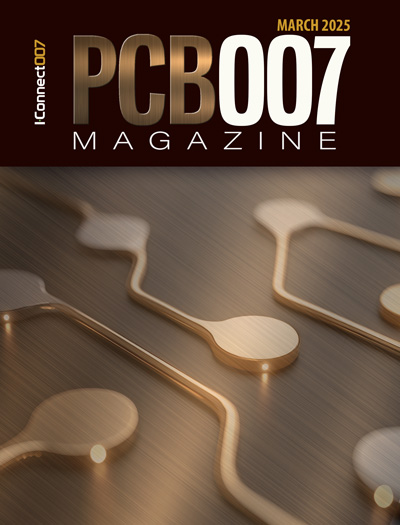-

- News
- Books
Featured Books
- pcb007 Magazine
Latest Issues
Current Issue
The Essential Guide to Surface Finishes
We go back to basics this month with a recount of a little history, and look forward to addressing the many challenges that high density, high frequency, adhesion, SI, and corrosion concerns for harsh environments bring to the fore. We compare and contrast surface finishes by type and application, take a hard look at the many iterations of gold plating, and address palladium as a surface finish.

It's Show Time!
In this month’s issue of PCB007 Magazine we reimagine the possibilities featuring stories all about IPC APEX EXPO 2025—covering what to look forward to, and what you don’t want to miss.

Fueling the Workforce Pipeline
We take a hard look at fueling the workforce pipeline, specifically at the early introduction of manufacturing concepts and business to young people in this issue of PCB007 Magazine.
- Articles
- Columns
Search Console
- Links
- Media kit
||| MENU - pcb007 Magazine
Part 2: EIPC’s Winter Conference in Lyon, France: Day 2 Review
February 21, 2018 | Pete Starkey, I-Connect007Estimated reading time: 9 minutes
Editor's Note: If you missed the beginning of this article, click here.
The final session, on European needs for new technology, product safety and training, was introduced and moderated by EIPC board member Dr. Michele Stampanoni, vice president of strategic sales and business development at Cicor Group.
His first presenter was Emma Hudson, vice-chairman of EIPC and UL’s industry lead for PCBs in Europe, the Middle East, Africa, and Latin America, continuing in her campaign to help the PCB industry through the safety certification process, this time by advising how the solder limits for UL-Recognised PCBs required to be updated to reflect the realities of surface mount assembly soldering processes. She explained that solder limits represented the soldering processes the PCB would be exposed to during assembly, and that many PCB fabricators were using outdated values related to wave soldering, where the traditional solder float conditions did not represent current SMT soldering processes. It was clear there was a significant possibility that PCBs passing the solder float test would not pass when SMT soldering processes were used. Therefore, using inaccurate solder limits for safety testing was not acceptable and if the recognised solder limits were exceeded in production then the recognition, which was in effect the safety assessment, would be invalidated,
To help make implementation easier, UL would be offering standardised soldering profiles based on IPC-TM-650 2.6.27 T230 and T260, although it was acknowledged that many different product-specific soldering profiles were in use, and that fabricators could define their own limits if they meaningfully represented the conditions their boards would experience. Ms. Hudson gave comprehensive guidance on how to define and interpret solder limits, and described the procedures for updating them for different base materials and multilayer constructions, explaining where the CCIL Program could and could not be used. Similarly, for solder resists, with examples of when the permanent coating program could and could not be used.
She advised that, commencing in 2018, UL follow-up services would require evidence of the actual soldering profiles used for the PCB assembly, to confirm that the soldering processes to which the PCB had been exposed did not exceed the recognised solder limits and so invalidate the recognition. But UL were prepared to help, and she urged fabricators to get in touch and get their requalification programmes in progress without delay.
In his presentation on printed electronics for flexible and conformal applications, Dr. Neil Chilton, technical director at Printed Electronics Limited (PEL), grouped printed electronics, flexible electronics, plastic electronics and organic electronics under one collective heading: large-area electronics, meaning processes that could be employed on roll-to-roll substrates or those that were generally in larger format than PCB or silicon processes. He gave a background to the market, which was expanding rapidly in the areas of displays and lighting, power, and logic and memory. There was a substantial market in printed sensors, dominated by mass-produced glucose test strips, but sustained growth was forecast for non-bio sensors, principally photodetectors, gas sensors and temperature sensors. In stretchable electronics, the key innovation areas were stretchable inks, flex-to-rigid connections, and sensor structures and materials. And sportswear was leading the way in Smart clothing.
IDTechEx had forecast that the market for stretchable and conformable electronics would reach $600M by 2017, and Dr. Chilton explored the opportunities for nano-metal inkjet printed circuits in this technology area. The principal benefit was that circuits could be printed directly onto a pre-existing surface, so eliminating the substrate and its weight. Because the technique was digital, additive and direct, it gave the benefits of additive manufacturing. A limitation was that the circuitry was usually thinner, more fragile and more resistive than conventional electronics, and could not carry significant current. He considered that single layers of inkjet were more applicable to direct-printed sensors than to general circuitry. However, if inkjet was used to print a seed layer, more substantial conductors could be built up with electroless copper.
Generally, inkjet inks were very low viscosity, so they needed a high-quality substrate and could not achieve the same resolution as photolithography. Neither was it easy to print on 3D surfaces. But PEL had developed a system for printing viscous inks by digital 3D deposition, which gave thicker deposits and could be used for antennas. Dr. Chilton showed examples of printing on cylindrical pre-forms for defence applications. It was also possible to use the technique for producing embedded electronics.
Continuing the theme of printed electronics, Hortense Gaya, product manager for DuPont PVAM inks at CCI Eurolam, discussed the latest developments in materials for applications in wearables and in-mould electronics.
She began by describing the formulation of a conductive ink: The base polymer required good elasticity, good adhesion to substrates and the ability to withstand high temperatures. The solvent needed the ability to effectively solubilise the polymer to give good screen printing properties and to be compatible with printed circuit and graphics inks. The filler could be a dielectric, the choice depending on whether it was for an under-print or an over-print application, or a conductor, for example silver or carbon. The resulting functional ink should have a balance of conductivity and stretchability, and a balance of viscosity and good printing properties, as well as compatibility with substrates and graphic inks.
The market for wearable electronics was expanding rapidly, predominantly in sport and fitness and healthcare, but also in home and lifestyle, industrial, commercial and military applications. Smart sportswear could monitor heart rate, breathing and muscle fatigue, using for example silver paste as a conductor and silver/silver chloride as electrodes and dielectric, optimised for stretchability and adhesion to a thermoplastic polyurethane substrate to give a comfortable garment. Combination with active components could enable wireless communication, processing of data and intelligent feedback systems. In healthcare applications, parents and caregivers could get real-time information on vital signs of infants or the elderly. In military or emergency-response situations, real-time monitoring of vital signs could protect personnel, environmental sensors could let personnel know when safety limits had been reached, and location monitoring could coordinate responses and facilitate rescue.
DuPont had developed a family of stretchable base and cover films, silver and carbon conductor inks and encapsulants specifically for applications in wearable electronics. Ms. Gaya reviewed processing techniques: combinations of screen printing, die or laser cutting and hot lamination to fabric, and discussed the evaluation and measurement of performance in terms stretchability and elastic durability, washability and comfort.
Moving on to the topic of in-mould electronics, which she defined as printed electronic circuits that had undergone a thermoforming and injection moulding process, she explained that the technique combined film, graphics and electronics, and that the circuitry, with or without mounted components, remained functional as the conductor tracks followed the contours of the 3D shape of the mould. Typical applications were 3D circuits with capacitative switches, and LED lighting controls in automotive, avionics and domestic appliances. There was a substantial weight saving, and buttons and wires were eliminated. DuPont had formulated a complete suite of electronic inks designed to survive the intense stretching and heat of the thermoforming and injection moulding processes.
Page 1 of 2
Suggested Items
Real Time with... IPC APEX EXPO 2025: New Dispensing and Coating Solutions from Rehm
04/03/2025 | Real Time with...IPC APEX EXPOMichael Hanke, Global Sales Officer at Rehm, discusses new dispensing and coating equipment developed in Germany. He emphasizes the significance of software integration with customer systems to tackle market challenges.
BEST Inc. Presents StencilQuik for Simplifying BGA Rework Challenges
04/02/2025 | BEST Inc.BEST Inc., a leader in electronic component rework services, training, and rework tools is thrilled to announce StencilQuik™ rework stencils. This innovative product is specifically designed for placing Ball Grid Arrays (BGAs) or Chip Scale Packages (CSPs) during the rework process.
Real Time with... IPC APEX EXPO 2025: Nordson's Expansion of Intelligent Technologies
04/02/2025 | Real Time with...IPC APEX EXPOJonathia Ang-Mueller gives an update on Nordson's latest selective soldering system which features a small footprint, offering cost savings and increased production capacity. Advanced software allows for pre-sales simulations, enhancing customer engagement.
Knocking Down the Bone Pile: Basics of Component Lead Tinning
04/02/2025 | Nash Bell -- Column: Knocking Down the Bone PileThe component lead tinning process serves several critical functions, including removing gold plating, mitigation of tin whiskers, reconditioning of component solderability issues, and alloy conversion from lead-free (Pb-free) to tin-lead or from tin-lead to lead-free for RoHS compliance. We will cover each of these topics in more detail in upcoming columns.
Real Time with... IPC APEX EXPO 2025: Innovations at Indium Corporation—A Look into the Future
04/02/2025 | Real Time with...IPC APEX EXPOIndium Corporation, led by CEO Ross Berntson, is making strides in automotive applications with innovative solder paste technologies. The company prioritizes sustainability and energy efficiency in manufacturing while developing its workforce through partnerships with local universities.


